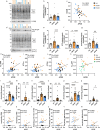Apolipoprotein E abundance is elevated in the brains of individuals with Down syndrome-Alzheimer's disease
- PMID: 40387921
- PMCID: PMC12089208
- DOI: 10.1007/s00401-025-02889-0
Apolipoprotein E abundance is elevated in the brains of individuals with Down syndrome-Alzheimer's disease
Abstract
Trisomy of chromosome 21, the cause of Down syndrome (DS), is the most commonly occurring genetic cause of Alzheimer's disease (AD). Here, we compare the frontal cortex proteome of people with Down syndrome-Alzheimer's disease (DSAD) to demographically matched cases of early onset AD and healthy ageing controls. We find dysregulation of the proteome, beyond proteins encoded by chromosome 21, including an increase in the abundance of the key AD-associated protein, APOE, in people with DSAD compared to matched cases of AD. To understand the cell types that may contribute to changes in protein abundance, we undertook a matched single-nuclei RNA-sequencing study, which demonstrated that APOE expression was elevated in subtypes of astrocytes, endothelial cells, and pericytes in DSAD. We further investigate how trisomy 21 may cause increased APOE. Increased abundance of APOE may impact the development of, or response to, AD pathology in the brain of people with DSAD, altering disease mechanisms with clinical implications. Overall, these data highlight that trisomy 21 alters both the transcriptome and proteome of people with DS in the context of AD, and that these differences should be considered when selecting therapeutic strategies for this vulnerable group of individuals who have high risk of early onset dementia.
Keywords: APOE; Amyloid precursor protein; Frontal cortex; Mass spectrometry; Neuropathology; Trisomy 21.
© 2025. The Author(s).
Conflict of interest statement
Declarations. Conflict of interest: The authors declare that they have no competing interests. F.K.W. has undertaken for fee consultancy for Alnylam Pharmaceuticals. Ethical approval: Human tissue: The use of human tissues in this study was in accordance with the UK Human Tissue Act (2004). Samples for the discovery cohort and validation cohort A were supplied, anonymized by the Newcastle Brain and Tissue Resource (NBTR), Newcastle University, Newcastle, UK and the South West Dementia Brain Bank (SWDBB), Bristol University, UK, and had full research consent (REC 19/NE/0008) and (REC 18/SW/0029). This work was carried out under NBTR and SWDBB’s NHS REC Research Tissue Bank ethical approval. Validation cohort B, studied at UCI, were obtained through IRB approved protocols and consent. Consent to publication: Not applicable.
Figures





Update of
-
Apolipoprotein E abundance is elevated in the brains of individuals with Down syndrome-Alzheimer's disease.bioRxiv [Preprint]. 2025 Feb 25:2025.02.24.639862. doi: 10.1101/2025.02.24.639862. bioRxiv. 2025. Update in: Acta Neuropathol. 2025 May 19;149(1):49. doi: 10.1007/s00401-025-02889-0. PMID: 40060680 Free PMC article. Updated. Preprint.
References
-
- Arai Y, Mizuguchi M, Ikeda K, Takashima S (1995) Developmental changes of apolipoprotein E immunoreactivity in Down syndrome brains. Dev Brain Res 87:228–232. 10.1016/0165-3806(95)00066-M - PubMed
Publication types
MeSH terms
Substances
Grants and funding
LinkOut - more resources
Full Text Sources
Medical
Miscellaneous

